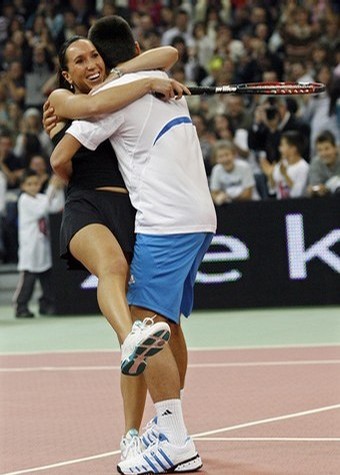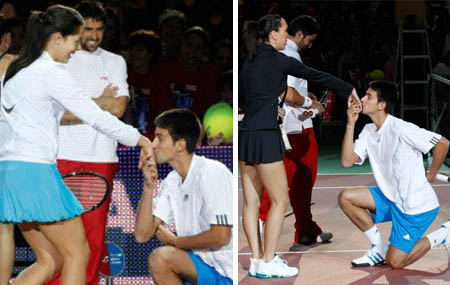Rarely does Djokovic whisper as he does here to his charming compatriot and Hopman Cup doubles partner, Jelena Jankovic. Generally, the ATP’s most engaging superstar proclaims his sentiments to the world in unambiguous fashion. Typical of this trait was the bravado with which he addressed his Friday confrontation againt Verdasco, who inflicted Djokovic’s worst defeat as a top-10 player two weeks ago in Monte Carlo. “I’ve played a lot of matches against him on different surfaces and I’ve won most of them,” trumpeted the Serb, who then announced that the aforemented match “wasn’t a real picture of my game.” Having talked the talk, can he walk the walk? His comments both will motivate him and place more pressure upon himself, thus increasing the intrigue in this first quarterfinal.
Considering the rather lopsided lineups created by the upsets in Rome and Stuttgart, we’ve decided to create our own quarterfinal lineup comprised of two matches from each tournament. From Rome, we’re taking Tsonga-Ferrer and Verdasco-Djokovic, jettisoning the bizarre Gulbis-Lopez nightcap and the foregone conclusion of Nadal-Wawrinka. (As we mentioned on Twitter earlier, we might see an all-Spanish semifinal lineup at the Foro Italico on Saturday.) From Stuttgart, we’re previewing Li-Stosur and Henin-Jankovic, omitting Safarova-Lapushchenkova and Peer-Safina. Since all four of our selected matches should be highly competitive, we’ll construct the argument for why one player should win and then devise a counterargument for why the other player might win. Therefore, you’ll be able to draw your own conclusions from the information provided!
Tsonga (7) vs. Ferrer (13):
Why Ferrer should win: Clay is the surface that most favors substance over style. Continuing his inspired play from Miami, Ferrer reached the semifinals in Monte Carlo and Barcelona, where he lost to the eventual champions on both occasions; strikingly, he leads all ATP players in clay-court wins this season, including the February events in South America. Although Murray’s struggles have been well-documented, Ferrer still impressed us on Thursday with his routine victory over the fourth seed. By contrast, Tsonga made little impact in either of the last two tournaments, falling to Ferrero and (mystifyingly) to De Bakker. In addition to his distinct advantage on the surface, Ferrer possesses a style ideally equipped to exploit the Frenchman’s sporadic inconsistencies. Numberless are the ATP shotmakers whom he has slowly stymied with his death-by-paper-cut tactics of bulletproof defense and crafty counterpunching. Even when Tsonga thinks that he’s hit an outright winner, he’ll need to hit one more…and one more…
Why Tsonga might win: This match is their first meeting, and Ferrer may need to adjust to Tsonga’s distinctive aggression before settling into the match. If the acrobatic Frenchman can convert some early opportunities, Ferrer occasionally has faded when he falls behind by a significant margin. A reliable barometer for his overall confidence, his tw0-handed backhand has been firing this week, and his often unreliable return game has been relatively solid. Also, the surface may not be quite so firmly allied with the Spaniard as one would suppose. Among others who prioritize power over consistency, Gulbis, Ljubicic, and Lopez have fared surprisingly well this week, suggesting that the clay may be playing a little faster than usual (but not so fast as the Porsche-speed grit in Stuttgart).
Verdasco (6) vs. Djokovic (2):
Why Djokovic should win: The Serb stated his own case rather well in the comments quoted above, but we’ll amplify them. Prior to the Monte Carlo catastrophe, he had defeated the Spaniard on five consecutive occasions, including two meetings on clay. Absent from Barcelona, he entered Rome far fresher than Verdasco, who won the title in that Mediterranean city and looked somewhat weary against Bolelli earlier this week. Spared the burden of facing Isner, Djokovic crushed Chardy before delivering a sturdy, focused performance against the potentially tricky Bellucci. Either way, the second seed largely controls the outcome of the match. If the confident, patient Novak of the 2009 clay season shows up tomorrow, he’ll win; if the nervous, nauseous-looking Novak of the Monte Carlo semifinal shows up, he’ll almost certainly lose. We think that the loss to Verdasco a fortnight ago stung a little more than he was willing to admit, judging from his pugnacious statements. He sounds motivated to avenge that embarrassment and has showcased the best tennis of his career when he has been most motivated.
Why Verdasco might win: Although he may have lost those five straight clashes with Djokovic, the Spanish #2 threatened him in four of them and will know that openings will emerge. Outside Nadal, he’s been distinctly the best player of the clay season so far, scoring wins over Berdych, Gulbis, Ferrer, and Soderling as well as Djokovic. Only an elite player at the height of his powers could overcome the diverse playing styles of those opponents in such a short period. Supporting claims of a strengthened mentality, Verdasco has performed with aplomb at crucial moments over the past few weeks. Shot for shot, he can equal Djokovic’s power and currently possesses more confidence in his game than does the Serb, who has long been tampering with his service motion. If he can seize the momentum early, Novak might lose self-belief and wander out of focus…and out of the tournament.
Li vs. Stosur (7):
Why Stosur should win: Simply put, she’s been doing a lot of winning lately, whether on the green clay of Charleston or for the Australian national team in Fed Cup. One might imagine that her serve-oriented game would not translate well to clay, but in fact she ignited her breakthrough last year by reaching the French Open semifinal; some analysts believe that her high-kicking second serve suits this surface better than the others. Far from a conventional clay court, the Stuttgart surface has been playing much like the indoor hard court formerly chosen by the tournament. (Did they just paint it red and call it clay?) Consequently, Stosur should be able to hold serve more comfortably than Li, which in turn should allow her to take chances and be aggressive in her return games–the pattern that has succeeded so regularly for her during this recent winning streak.
Why Li might win: Rather like Verdasco, Stosur may be rather fatigued after winning her most recent tournament and a trip to Ukraine for the Fed Cup playoff. Hinting at a slight decline in her form, she struggled early against the respectably but not eye-poppingly talented Alexandra Dulgheru. More importantly, Li showcases a far better backhand than does the Australian and will win most of the backhand-to-backhand exchanges. Unless Stosur can take control of the points early and run around her backhand to hit swarms of forehands, she’ll be in trouble against the symmetrical groundstroke game of the Chinese star. When Li is at her best, moreover, she can topple anyone on any surface; her straight-sets win over defending champion Kuznetsova recalled the form with which she reached the semifinals in Melbourne.
Henin (W) vs. Jankovic (4):
Why Henin should win: Thoroughly dominant on the clay during her “first career,” the four-time French Open champion holds a 9-0 career record against Jankovic. Mentally more tenacious than Jelena, Justine has rallied from a one-set deficit against her three times, so she’ll remain confident if any early adversity should arise. They played an astounding seven times in the single season of 2007 , including three times on clay, and Henin has won the last ten sets. (Dept. of Odd Statistics: she was responsible for over a quarter of Jankovic’s total losses that year.) In her comeback so far, she has suffered only one loss to a non-Slam champion (Dulko at Indian Wells) while reaching at least the semis in three of four tournaments. Although Jankovic has lost just eight games during her first four sets this week, she is struggling with a left wrist injury that undermines her principal weapon; just as the Belgian owns the most beautiful one-hander in the WTA, the Serb owns one of the loveliest two-handers.
Why Jankovic might win: The smiling Serb may be coping with a wrist injury, but Henin will need to overcome a broken finger, albeit on her left and much less significant hand. As one would expect from an offensive-oriented player early in a comeback, she has struggled with extended stretches of erratic play when her shot-making radar temporarily loses its range. Jankovic’s consistency will not let the Belgian easily escape from donated points and games. While Henin has struggled with her modified service motion thus far, the Serb’s delivery has improved since the seven reverses of 2007. She’ll never have a better chance to break the Curse of Carlos, before Henin fully hones the ultra-aggressive style with which she has entered her “second career.”
After losing to Henin for the ninth time, Jankovic quipped that no player ever vanquishes her ten times in a row. When the petite Belgian retired in May 2008, the Serb looked safe from the danger of proving her words. Will she prove them now?
Having started and ended our text with the Serbs, we’ll start and end the article with images of them as well. Djokovic finds himself in a rather enviable position here…
…and in an even more enviable position here…
…and in a less comfortable but still enviable position here:
Enjoy the quarterfinals!
Comment
© 2026 Created by Mark / The Mayor.
Powered by
![]()




You need to be a member of Tennisopolis : Tennis Social Network to add comments!
Join Tennisopolis : Tennis Social Network